The Mellow Bakers have been working on Ciabatta this month. We had three different versions to choose from: Ciabatta with Stiff Biga, Ciabatta with Poolish, or Ciabatta with Olive Oil & Wheat Germ. I decided to make the Ciabatta with Olive Oil & Wheat Germ the day before Christmas Eve so we would have an easy and quick dinner on Christmas Eve.
Ciabatta means slipper in Italian. The dough is very wet and slack so you typically don’t shape this bread, you just divide the dough and stretch out the pieces a little bit. When I made Ciabatta for the BBA Challenge, the loaves turned out looking like an old shoe rather than a slipper. My second attempt turned out better, but it still wasn’t my favorite dough to work with.
This time, however, the dough was easier to work with. It was wet, but the addition of the wheat germ and olive oil, made it very manageable. The loaves still look pretty funny, but they tasted good.
Ciabatta with Olive Oil and Wheat Germ
From the book: Bread: A Baker’s Book of Techniques and Recipes by Jeffrey Hamelman
You can find a copy of the formula here.
This is the method I used to make this bread:
POOLISH: Disperse the yeast in the water, add the flour, and mix until smooth. Cover the bowl with plastic and let stand for 12 to 16 hours at about 70° F.
MIXING: Add all the ingredients to the mixing bowl, including the polish and toasted wheat germ, but not the olive oil. In a stand mixer, mix on first speed for 2 ½ minutes in order to incorporate the ingredients. If necessary, correct the hydration by adding water or flour in small amounts. Turn the mixer to second speed and begin to add the olive oil in a slow, steady stream. Mix on second speed for 4 ½ to 5 ½ minutes, until gluten development is evident. The dough will be rather loose and sticky, but when tugged on, some definite dough strength should be noted — there should be some “muscle” to the dough. Notice the nice flecks of what germ spread throughout the dough. Desired dough temperature: 75° F.
BULK FERMENTATION: 3 hours.
FOLDING: Fold the dough twice, after 1 hour of bulk fermentation and again after 2 hours. To do so, flour the work surface, using somewhat more flour than you think is necessary. Excess flour will not be incorporated into the dough because it will all be brushed off. Turn the dough out onto the work surface, so that the top of the dough is neatly turned over and spread onto the floured work surface. Now take one side, say, the left side of the dough, and lift up about one-third of the bulk and turn it vigorously onto the body of the dough.
With spread fingers, use both hands to pat down the dough and degas it. Don’t attempt to drive out every bit of fermentation gas; just press enough to expel the major portion of the gases.
Now take about one-third of the dough from the right side and fold it in toward the center, overlapping the first fold.
Again press to degas. Be sure, before that second folding and prior to all folds, that any raw flour on the top surface of the dough is brushed away. I didn’t use any extra flour for this part. This particular Ciabatta dough didn’t need it.
After folding the right-hand third of the dough into the center, reach over to the far side of the dough, bring about one-third toward you, and fold this portion.
Finish by taking the dough closest to you and folding that portion away from you and into the center.
When this fourth side has been folded, turn the dough over on the work surface so the seams are underneath, bring your hands under the dough from the left and right sides, pick it up in a mass and replace it in the dough container. The folds give a final strengthening to the dough.
DIVIDING AND SHAPING: Flour the work surface. Invert the dough onto the work surface and gently pat out the larger air bubbles — but remember that for the most part the fermentation gasses and the associated interior holes and pockets in the dough should remain intact. Lightly flour the top surface of the dough. Have ready a sufficient number of bread boards (or a baker’s couche) that are thoroughly (but not too thickly) covered with sifted bread flour.
Using a pastry cutter that has been dipped in water, divide the dough into three approximately equal rectangles. Each should weigh about 18 ounces. I cut the dough into four rectangles instead of three.
Lay the loaves on the cloth (or a floured bread board).

Gently fold each piece of dough, from left to right, letter style, into an oblong about 6 inches long.
Bunch the cloth between the pieces to provide a wall. Mist the top of the dough with spray oil and dust the dough with more flour, then cover the cloth with a towel. I used plastic wrap instead of a towel.
FINAL FERMENTATION: Approximately 1 1/2 hours at 75° F.
Prepare the oven for hearth baking. About 45 minutes to 1 hour before baking, place a baking stone on the middle rack with a steam pan underneath. Preheat oven to 500 degrees Fahrenheit.
BAKING: Dust a peel or the back of a sheet pan with semolina flour or cornmeal and very gently transfer the proofed ciabatta dough to the peel or pan. Or, use a piece of parchment paper and dust it with cornmeal.
Lift the dough from each end and tug the dough out to a length of 9 to 12 inches. If the dough bulges too high in the middle, gently dimple it down with your fingertips to even out the height of the dough.
Slide the dough onto the stone. Pour 1 cup of hot water into the steam pan and close the door. After 30 seconds, open the door, spray the side walls of the oven with water, and close the door. Repeat twice more at 30-second intervals. After the final spray, turn the oven setting down to 450 degrees F and bake for 10 minutes. Rotate the loaves 180 degrees, if necessary, for even baking and continue baking for 5 to 10 minutes longer, or until done.
The bread should register 205 degrees F in the center and should be golden in color. The flour streaks will also give it a dusty look. The loaves should feel quite hard and crusty at first but will soften as they cool.
COOLING & SERVING: Remove the loaves from the oven, let them cool fully (about 45 minutes) before slicing and eating.
I really like the flavor of the Olive Oil and Wheat Germ Ciabatta. We used these loaves for sandwiches. We sliced them and served them with Italian sausage and marinara sauce. Here is the shot of the crumb. I don’t have photos of the sandwiches. We were too hungry to wait for photos.
Thanks for visiting the Bread Experience bread-baking blog. I hope you’ll join me again soon.
Happy Baking!
Cathy

Mellow Bakers was started by Paul at Yumarama.
We’re baking breads from Bread: A Baker’s Book of Techniques and Recipes by Jeffrey Hamelman.
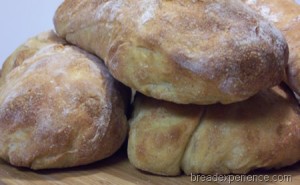
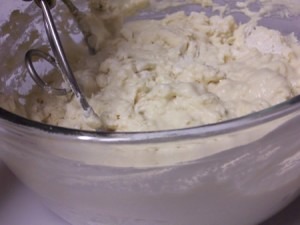

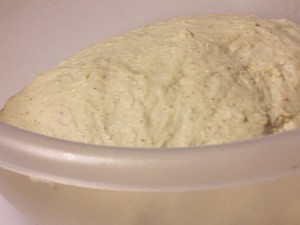
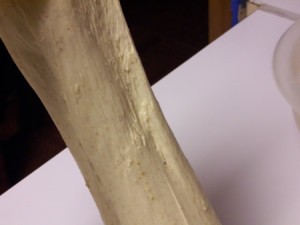
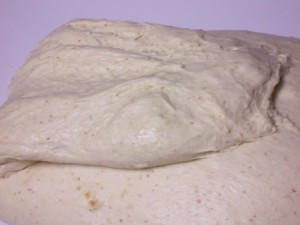
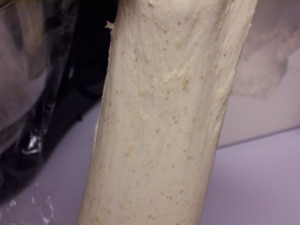
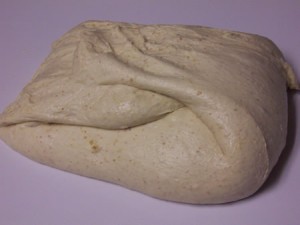
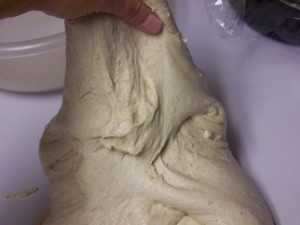
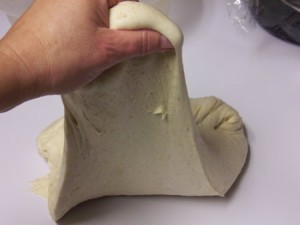
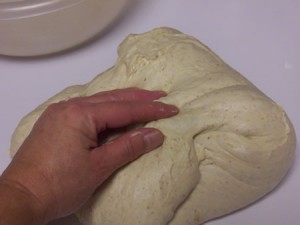
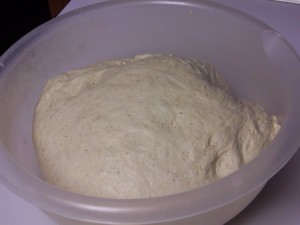
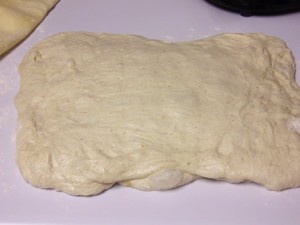
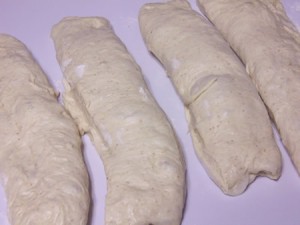
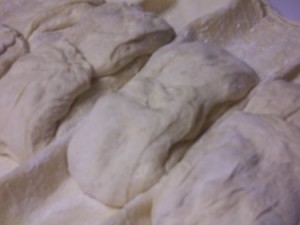
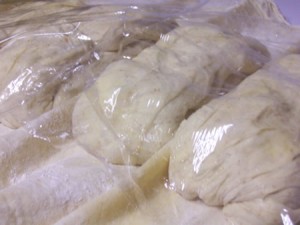
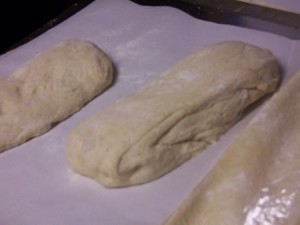
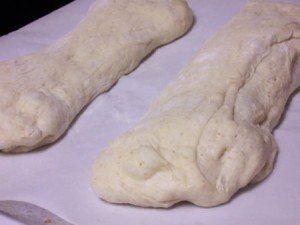
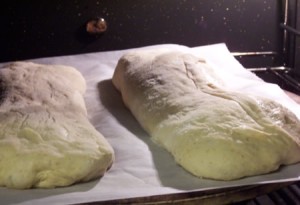
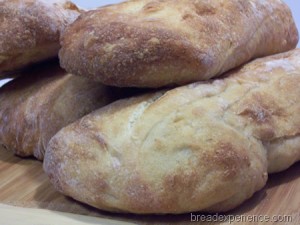
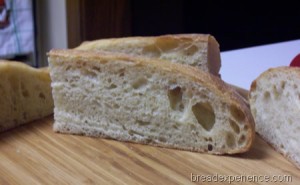
TeaLady says
Thanks for this great picture tutorial. Does look/sound like very tasty bread.
Michelle says
On my gosh…what gorgeous crumb! One of the best I’ve ever seen!
The only Ciabatta I’ve ever made was Reinhart’s a I just loved it. In fact it was my favorite bread from the entire book!
Mary J says
Looks yummy, I’ll have to try this soon. I have the book but have only made the Rustic Bread on page 115. Delicious, too. Happy New Year!
Anonymous says
I love all you do.. I do wish you would make a printable version for all your recipes
Cathy (breadexperience) says
Thank you for the feedback. I will consider adding a printer-friendly version to blog posts where appropriate.
You can also find bread recipes on my site breadexperience.com that do include a printable version.